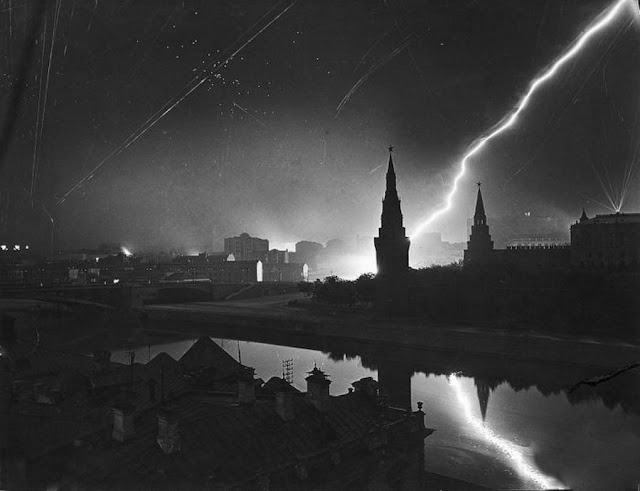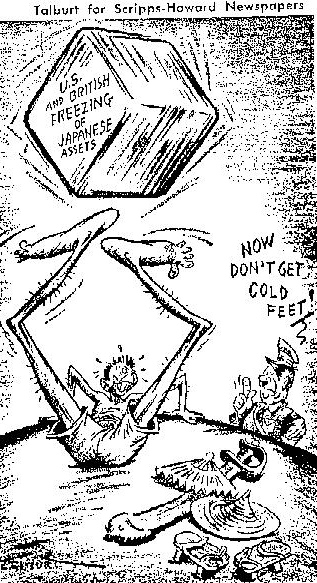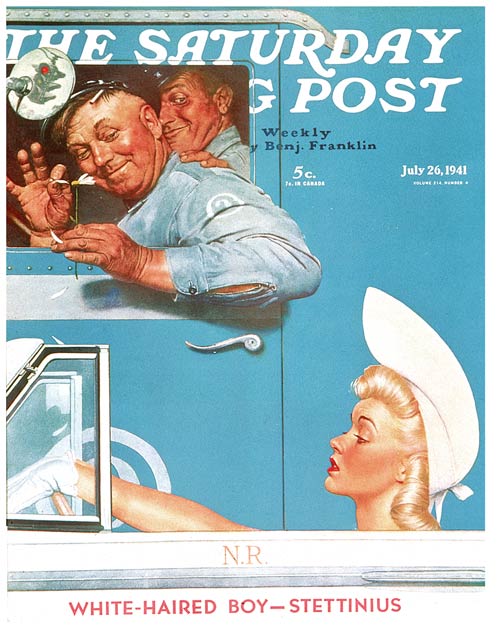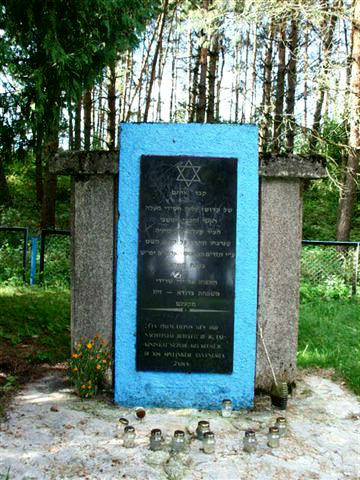Saturday 26 July 1941
 |
| Blacked-out Moscow during the air raid of 26 July 1941 (Margaret Bourke-White). |
The Germans are eager to assume that the Soviets already are defeated. General Halder notes in the OKH war diary, "The mass of the operationally effective Russian Army has been destroyed." That is not, of course, the truth, and, in fact, the Wehrmacht is stalled on many of its fronts in the USSR at the moment.
 |
| Finnish soldiers pose on a captured Soviet bunker, 26 July 1941. |
In the Army Group North sector, the Red Army activates the 34th Army south of Lake Ilmen. Heavy fighting continues in the area as the panzers in the spearhead wait for infantry to close up and form a secure front.
In the Army Group Center sector, the Wehrmacht continues to subdue the three Soviet armies trapped in the Mogilev pocket. Mogilev itself is taken today, but Soviet resistance outside the town continues. German Second Army slowly advances against desperate Soviet resistance. Among the scorched-earth activities of the Soviet troops is their destruction of the local brewery to withhold the taste of victory from the German soldiers.
 |
| A Soviet T-26 Anisimowa, July 1941. |
The men are indifferent and apathetic, are partly suffering from crying fits, and are not to be cheered by this or that phrase. Food is being taken only in disproportionately small quantities.Quite an unexpected description of a "victorious army." Of course, the Soviets are no better off, but there is no question that the Wehrmacht spearheads are getting ground down from constant combat.
In the Army Group South sector, the Germans and Romanians capture Olgopol in the Vinnytsia district. The Romanians attach Olgopol to their province of Transnistria.
The Luftwaffe bombs Moscow again for the fourth time in a week. Bombs fall near the Kremlin. The Luftwaffe only sends 50 bombers over the city, half the number as on the previous attack. Kapitan Konstantin Titenkov shoots down a German bomber for the fourth time in four air raids, earning him the Order of Lenin and a Gold Star signifying that he is a Hero of the Soviet Union.
 |
| Another photo by Margaret Bourke-White in Moscow, 26 July 1941. |
Hitler personally decorates fighter ace Werner Mölders with the Diamonds to his Knight's Cross.
Battle of the Baltic: Finnish (or German) shore-based artillery hits and sinks 1375-ton Soviet freighter Metallist at Soviet-occupied Hango in Southern Finland.
German torpedo boat T-3 reports sinking Soviet destroyer Tsiklon (or perhaps another destroyer) during a surface action. However, there is no verification.
Soviet torpedo boats attack the German 2nd R-Boat Flotilla in the Irben Strait. They sink German minesweeper R.169.
The German 3rd S-Boat Flotilla attacks Soviet shipping north of Riga, without result.
The Soviet Red Air Force attacks and sinks German minesweeper R-169 in the port of Vindova. There are 11 deaths and 12 crew wounded.
Soviet submarine K-3 lays mines off Bornholm.
 |
| Near Smolensk, Fw. Heinrich Klopper belly-landed his Bf 109 F-2 "Rote 1" (Red One) on 26 July 1941. Klopper is in IV./JG 51 (as indicated by the cross on the rear of the plane). |
Atlantic City is taken in tow to Buncrana, Ireland. Schüler writes in his log that he also torpedoed another ship, but there is no evidence of that. Royal Navy escorts Walker, Vanoc, Volunteer, Sardonyx, Scimitar, and Norwegian Bath, along with corvettes Bluebell and Hydrangea, launch a 20-hour depth charge attack. U-141 escapes.
- 5133-ton British freighter Atlantic City (damaged, crew abandons ship but later reboards, all 41 survive)
- 5106-ton British freighter Botwey (sunk, all 53 survive)
Italian submarine Barbarigo is operating hundreds of miles west of Casablanca when it torpedoes and sinks 8272-ton British tanker Horn Shell. There are 17 deaths, while the survivors are taken aboard Portuguese trawler Maria Leonor and then transferred to Royal Navy destroyer Avon Vale.
The Luftwaffe bombs and sinks 213-ton British fishing trawler Strathlochy about 180 miles northwest of Rora Head, Orkneys.
Royal Navy destroyer HMS Broke and Verity collide near Londonderry while escorting Convoy SL-80. Both destroyers sustain damage that keeps them out until mid-September, Broke at Hebburn on Tyne and Verity at Belfast.
In Lisbon, US transport USS West Point (AP-23, formerly liner SS America) embarks American and Chinese diplomats and their families who have been expelled from Germany and Italy. Some other US refugees also are taken on board, including 21 US passengers who were on Egyptian ship SS Zamzam when sunk by German raider Atlantis on 17 April 1941.
 |
| The Remnants of the Saint Elmo Bridge in Valletta destroyed in the attack of 26 July 1941 and never repaired (Корниенко Виктор). |
U-109 (Kptlt. Heinrich Bleichrodt), on its sixth patrol out of Lorient, sneaks into Cadiz Harbor during the night and refuels from an "interned" German tanker before resuming its patrol west of Gibraltar.
Operation EF, the planned strike on Kirkenes, continues. British Force F, having refueled at Seidisfjord, Iceland, leaves for northern Norway. Force A departs from Scapa Flow (Operation FB).
Royal Navy destroyers bombard Dieppe, France as part of continuing Operation Gideon.
Convoy ON-1 departs from Liverpool.
Royal Navy corvette HMS Rockrose and minesweeper Deloraine are launched.
Canadian corvette HMCS Weyburn is launched at Port Arthur, Ontario.
U-116 (Korvettenkapitän Werner von Schmidt) and U-134 (Kapitänleutnant Rudolf Schendel) are commissioned, U-251 and U-437 are launched.
 |
| The Italian plan of attack on Malta Harbor, 26 May 1941. |
An audacious Italian attempt to infiltrate Malta's Grand Harbour in order to sink British shipping fails. The plan depends upon removing anti-submarine netting from the Saint Elmo Bridge. The Italians set charges and do remove the netting - but the charge also causes the bridge holding the netting to collapse and block the entrance. The fiasco traps the Italians, who are fired upon by harbor guns at Elmo and Ricasoli, and those who survive soon surrender. There are 18 Italian prisoners/deaths. The incident provides fine entertainment for Maltese citizens watching from the nearby shore.
Italian torpedo boats MAS-451 and 452 are bombed and damaged, sunk or captured off Malta, apparently as part of the operation to infiltrate Grand Harbour.
Operation Guillotine, the British reinforcement of Cyprus, continues. Royal Navy sloop Flamingo escorts transport Salamaua from Port Said to Famagusta.
The Italians raise destroyer Leone Pancaldo. It was sunk by the RAF on 10 July 1940 in Augusta Harbor during an attack by Swordfish of No. 813 Squadron launched from HMS Eagle. The Italians return it to service.
Convoy MG-1, the part of Operation Substance in which empty freighters from Malta depart, arrives in Gibraltar.
The Luftwaffe bombs Alexandria during the night.
 |
| USS San Diego is launched, 26 July 1941. |
Battle of the Pacific: Admiral Husband Kimmel, responding to the war alert issued from Washington, orders long-range air patrols to search for Imperial Japanese Navy ships.
US anti-aircraft cruiser USS San Diego is launched in Quincy, Massachusetts. It is the third ship in the Atlanta class of light cruisers. While launched on the East Coast, the ship serves in the Pacific Theater and participates in major battles such as the Naval Battle of Guadalcanal.
Terrorists: La Cagoule terrorists kill former French Minister René Marx Dormoy 51, by planting a bomb in his house. Dormoy, as Minister of Interior in November 1937, imprisoned 70 Cagoulards. The Cagoule terrorists work both sides of the war, some siding with the Petain Vichy Regime and others defecting to the Resistance or Charles de Gaulle's Free French. Dormoy opposed Petain and is under house arrest at the time of his death. The Dormoy killing doesn't appear related to partisan operations, since Dormoy is a critic of the Vichy government, but simply is an act of pure revenge.
 |
| Harold Talburt, Scripps Howard. |
Anglo/Dutch/Japanese Relations: Britain and the Dutch East Indies freeze all Japanese assets. The British government issues a "notice of denunciation" of all commercial agreements with Japan. In conjunction with the similar US actions today, his causes Japan to lose about 75% of its overseas trade, most of its wheat imports, and 88% of its imported oil. Many other strategic items such as iron ore, bauxite, and manganese also are denied to Japan. Japan has three years of oil supplies stored, but that is at peacetime consumption levels - and a war would cut into stockpiles quickly.
Japan quickly freezes US, British, and Dutch assets in Japan.
 |
| Saturday Evening Post, 26 July 1941. "The Flirts" by Norman Rockwell. |
Anglo/Soviet Relations: British Prime Minister Winston Churchill sends a message to Soviet Premier Joseph Stalin (received today) promising to send 200 P-40 Tomahawk woolens, 2-3 million ankle boots, and "during the present year large quantities of rubber, tin, wool and woolen clothes, jute, lead and shellac." He adds that, where Great Britain cannot supply Soviet requirements, "we are discussing matters with the U.S.A."
 |
| The New York Times, 26 July 1941. |
US Military: President Roosevelt federalizes the Philippine Army. He recalls to active US Army service retired US general and Philippines Field Marshal Douglas MacArthur. Chief of Staff General Marshall texts to MacArthur:
YOU ARE HEREBY DESIGNATED AS COMMANDING GENERAL COMMA UNITED STATES ARMY FORCES IN THE FAR EAST STOP YOU ARE ALSO DESIGNED AS THE GENERAL OFFICER UNITED STATES ARMY REFERRED TO IN A MILITARY ORDER CALLING INTO THE SERVICE OF THE ARMED FORCES OF THE UNITED STATES THE ORGANIZED FORCES OF THE GOVERNMENT OF THE COMMONWEALTH OF THE PHILIPPINES DATED JULY 26 COMMA 1941 STOP ORDERS CALLING YOU TO ACTIVE DUTY ARE BEING ISSUED EFFECTIVE JULY 26 COMMA 1941 STOP REPORT ASSUMPTION OF COMMAND BY RADIO END.The Philippine troops are made part of the US military "for the period of the existing emergency."
The US Army promotes MacArthur to Lieutenant General and commander of U.S. Army Forces in the Far East (USAFFE). As a condition of his return to service, MacArthur demands and receives a US $50 stipend per soldier serving in the Philippine National Army. This is not a unique arrangement, but MacArthur's aide Dwight D. Eisenhower refuses his similar stipend.
The US Army Philippine Department has 22,000 troops in total, including 12,000 Philippine Scouts. Major General Jonathan M. Wainwright commands the Philippine Division, which has the majority of the soldiers. However, the troop strength is deceptive, because the US Congress has been parsimonious in supplying weapons and supplies to the Philippines and other Pacific outposts.
British Military: Roderick Carr becomes commanding officer of RAF No. 4 Group.
 |
| An Italian E-boat (actually converted tourist boats) used in the 26 July 1941 attack on Valletta Harbour, Malta. |
German Government: During the night, Hitler engages in random ruminations with his cronies as he is wont to do. Tonight, his subject is royalty:
Monarchy is doomed. The people needs a point upon which everybody's thoughts converge, an idol. A people that possesses a sovereign of the stature of Frederick the Great can think itself happy; but if he's just an average monarch, it's better to have a republic.In a sense, Hitler here predicts the age of celebrity that sprouts later in the 20th Century.
Canadian Government: The Arvida strike in a key defense industry continues. Canadian Munitions and Supply Minister C. D. Howe offers his resignation out of frustration over his inability to use troops to end the strike. He ultimately agrees to stay on in exchange for being granted greater powers to deal with such strikes.
 |
| The Kelme memorial plaque. |
The local Judenrat announces that the Bialystok Ghetto is to be set up beginning today and extending through early August 1941. It is in the newly formed Bezirk Bialystok district within occupied Poland. It will house about 50,000 Jews. Jews have five days to get into the Ghetto, located in an area immediately north of Kosciuszko Square. The Germans compel the Jews to construct a 2.5 meter-high wooden fence around the ghetto, topped with barbed wire.
At Lvov, local Ukrainians seize thousands of Jews and beat to death a large number estimated at 2000+ between 25-27 July. The Ukrainians harbor a grudge based upon the 1926 murder of antisemitic leader Simon Petliura by Shalom Schwarzbard, a Jew.
Germans take over Stanisławów County in prewar Poland from the Hungarian army, who took it from the Soviets on 2 July. The Germans immediately compel the establishment of a Judenrat, to be headed by Israel Seibald.
A Lithuanian report dated 26 July 1941 counts the number of Jews living in Marcinkonys. This includes 50 under the age of 6. They will all be exterminated over the coming years.
At Kelme, Lithuania, 485 Jews are killed. This incident is commemorated with a memorial plaque. A total of 2000 Jews are killed in Kelme during July (according to the United States Holocaust Institute).
 |
| Night raid on Moscow, 26 July 1941 (Margaret Bourke-White). |
There is an attitude of lawlessness in Vilna where treatment of Jews is concerned, with Germans and Lithuanians feeling free to break into Jewish homes and plunder them without legal retribution. According to today's report of the Einsatzgruppen:
The antagonism between the Poles and the Lithuanians continues in the Vilna area... However, the Germans' measures, especially those against the Jews, have met with general consent.As this shows, one of the tricks the Germans use to enforce their policies in the occupied eastern territories is to exploit latent grudges by one group of people against another.
The Germans arrest the Vilna Judenrat and hold its members as hostages. They demand a large sum of money for their release, much of which must be turned over by the morning of the 27th.
Polish Homefront: Kazimierz Władysław Bartel, former Prime Minister of Poland, is killed on orders of Heinrich Himmler at dawn. The event is surrounded in mystery, but apparently, Bartel refuses a "request" to lead a puppet government for the Germans and is shot near Piaski Janowski in the same manner as those used in the murder of Polish professors from Lwów.
 |
| Albert Einstein's letter to Eleanor Roosevelt, 16 July 1941. |
 |
| The Australian Women's Weekly, 26 July 1941. |
July 1941
July 1, 1941: US TV Broadcasting Starts
July 2, 1941: MAUD Report
July 3, 1941: Stalin Speaks
July 4, 1941: Pogroms in Eastern Europe
July 5, 1941: Germans on Schedule
July 6, 1941: Australians Attack Damour
July 7, 1941: US Marines in Iceland
July 8, 1941: Flying Fortresses In Action
July 9, 1941: British Take Damour
July 10, 1941: Sword and Scabbard Order
July 11, 1941: Cease-fire in Syria and Lebanon
July 12, 1941: Anglo/Russian Assistance Pact
July 13, 1941: Uprising in Montenegro
July 14, 1941: Katyusha Rocket Launchers in Action
July 15, 1941: Smolensk Falls
July 16, 1941: Stalin's Son Captured
July 17, 1941: Heydrich Orders Mass Executions
July 18, 1941: Twin Pimples Raid
July 19, 1941: V for Victory
July 20, 1941: The Man Who Wouldn't Shoot
July 21, 1941: Moscow in Flames
July 22, 1941: Soviet Generals Executed
July 23, 1941: Secret Plan JB 355
July 24, 1941: Operation Sunrise
July 25, 1941: US Naval Alert
July 26, 1941: Italian E-Boat Attack on Malta
July 27, 1941: MacArthur Returns
July 28, 1941: Auschwitz Exterminations
July 29, 1941: Rescue From Crete
July 30, 1941: Raid on Petsamo and Kirkenes
July 31, 1941: Final Solution Order
2020
No comments:
Post a Comment